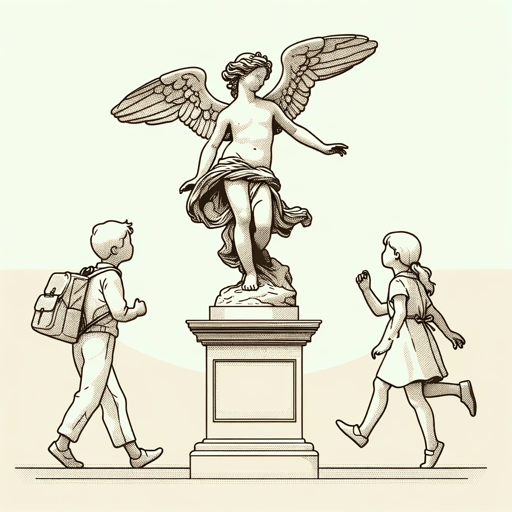74 pages • 2 hours read
E. L. KonigsburgFrom the Mixed-Up Files of Mrs. Basil E. Frankweiler
Fiction | Novel | Middle Grade | Published in 1967A modern alternative to SparkNotes and CliffsNotes, SuperSummary offers high-quality Study Guides with detailed chapter summaries and analysis of major themes, characters, and more. For select classroom titles, we also provide Teaching Guides with discussion and quiz questions to prompt student engagement.
Summary and Study Guide
Overview
From the Mixed-Up Files of Mrs. Basil E. Frankweiler is a 1967 children’s novel by E. L. Konigsburg. With elements of mystery and adventure, the novel follows two children who run away from home to hide out in the Metropolitan Museum of Art, where they are drawn into a mystery involving a newly acquired sculpture, even as they learn about themselves and the world around them. Praised for its humor and characters, the novel won the Newbery Medal in 1968. Now recognized as a classic, From the Mixed-Up Files was listed as one of the Teachers Top 100 Books for Children by the National Education Association in 2007, while it ranked seventh on a list of the best children’s novels published by School Library Journal in 2012. The novel has been adapted for film twice: first, a 1973 version starring Ingrid Bergman, then again in 1995, starring Lauren Bacall. Citations in this guide refer to the 2013 Atheneum Books edition.
Plot Summary
The novel is framed as part of a letter from Mrs. Basil E. Frankweiler, a wealthy, elderly art collector, to her lawyer, Mr. Saxonberg. In the letter, Mrs. Frankweiler explains her decision to alter her will to leave a valuable sketch by Michelangelo to two children, Claudia and Jamie Kincaid, who happen to be Saxonberg’s grandchildren. She proceeds to narrate the following events, writing about what happens with her own commentary mixed in.
Twelve-year-old Claudia Kincaid is increasingly annoyed by her home life in Greenwich, Connecticut, where she feels underappreciated compared to her three younger brothers. To teach her parents a lesson, she decides to run away from home. After enlisting the help of her nine-year-old brother Jamie, a frugal cards player who has stockpiled lots of money, Claudia sets her sights on the Metropolitan Museum of Art in New York City. Through careful planning and some luck, she and Jamie travel to the museum for free. On the way, she mails a letter home, telling her parents not to worry. When Jamie complains about Claudia’s choice of destination, she puts him in charge of their money.
After walking from the train station to the museum because Jamie refuses to pay for a bus pass, they pick out a historical bed on display in the museum to sleep in that night. After the museum closes, they hide in the bathrooms and wait for the staff to leave. Over the next few days, they explore the museum. They are particularly impressed by a newly arrived statue called Angel, which may or may not be by the famous Italian sculptor Michelangelo. They learn that Mrs. Frankweiler sold the statue to the museum at the relatively low price of $225.
On their third day away from home, Claudia and Jamie do laundry and visit local libraries to learn all they can about Michelangelo, hoping to discover whether he sculpted Angel. That night, they bathe in one of the museum’s fountains, gathering coins thrown in by the museum’s visitors.
When Angel is moved to a new location in the museum, Claudia and Jamie notice the imprint of Michelangelo’s mark left on the velvet where Angel stood earlier. Thrilled by their discovery, they write an anonymous letter to the museum staff explaining what they learned. To their disappointment, the museum staff respond with a letter explaining that they are already aware of the mark, which does not prove that Michelangelo created the sculpture.
Disappointed, Jamie suggests they return home, but Claudia insists that they visit Mrs. Frankweiler. Using the rest of their money to travel to Mrs. Frankweiler’s home in Connecticut, they ask her to tell them about Angel. At first, she refuses to tell them, but after she sees how determined they are, she allows them to search her file cabinets for information about Angel. In return, they agree to tell her about their stay in the museum.
Searching through Mrs. Frankweiler’s files, Claudia and Jamie find a sketch of Angel drawn by Michelangelo. When they ask Mrs. Frankweiler why she sold Angel at such a low price when she could have gotten much more money if she revealed Michelangelo as the artist, Mrs. Frankweiler explains that she values the secret more than the money. She suggests that knowing the secret will allow Claudia to return home changed, and she agrees to leave Michelangelo’s sketch to Claudia and Jamie in her will as long as they don’t tell anyone about it. She also interviews each of them about their time in the museum, allowing her to write the manuscript that makes up the novel.
As Mrs. Frankweiler’s chauffeur drives the Kincaid children home, they plan to return and visit Mrs. Frankweiler, whom they now view as a grandmother. Mrs. Frankweiler concludes her letter to Saxonberg with an invitation that he meet her at the museum, as well as a request that he not reveal his connection to her to the children, since she likes to keep secrets. Through Claudia and Jamie’s journey, Konigsburg demonstrates such themes as the vitality of human connection, the struggle for self-determination, and the allure of art.
Related Titles
By E. L. Konigsburg
Featured Collections
Action & Adventure
View Collection
Art
View Collection
Brothers & Sisters
View Collection
Childhood & Youth
View Collection
Coming-of-Age Journeys
View Collection
Jewish American Literature
View Collection
Juvenile Literature
View Collection
Newbery Medal & Honor Books
View Collection
Popular Study Guides
View Collection
School Book List Titles
View Collection



